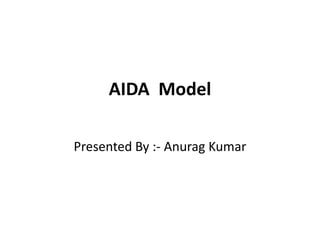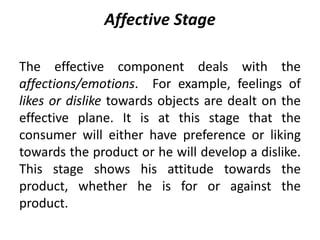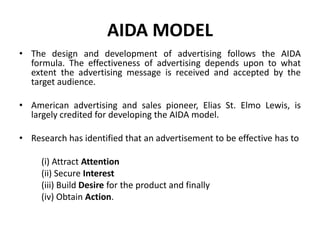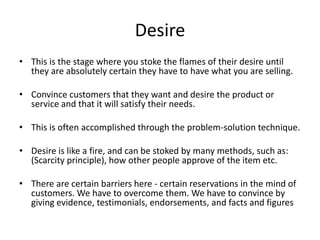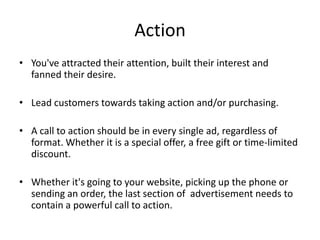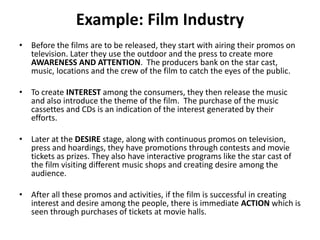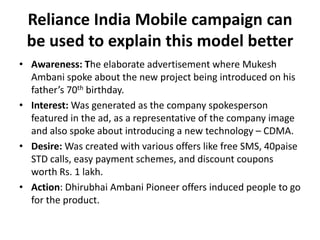Aida presentation
- 1. AIDA Model Presented By :- Anurag Kumar
- 2. COMMUNICATION MODELS BASED ON THE THREE STAGES OF BUYING BEHAVIOUR
- 3. Cognitive Stage The cognitive component deals with cognition, or knowledge; it is the power of knowing, perceiving or conceiving ideas about the product. It is dealing with the basic information that a consumer needs to know. A customer needs to be exposed to the product and understand its usage before he actually purchases it.
- 4. Affective Stage The effective component deals with the affections/emotions. For example, feelings of likes or dislike towards objects are dealt on the effective plane. It is at this stage that the consumer will either have preference or liking towards the product or he will develop a dislike. This stage shows his attitude towards the product, whether he is for or against the product.
- 5. Behaviour Stage This is the stage when the consumer, after having the knowledge and developing the liking or disliking towards the product, will ultimately lead into a purchase of the product or rejection of the product. He would first try the product and develop loyalty towards it or he is completely convinced that the product is good and would purchase the product.
- 6. AIDA MODEL • The design and development of advertising follows the AIDA formula. The effectiveness of advertising depends upon to what extent the advertising message is received and accepted by the target audience. • American advertising and sales pioneer, Elias St. Elmo Lewis, is largely credited for developing the AIDA model. • Research has identified that an advertisement to be effective has to (i) Attract Attention (ii) Secure Interest (iii) Build Desire for the product and finally (iv) Obtain Action.
- 8. Attention • Most campaigns rely on a mix of visual stimuli Typography , Color, Layout , Size , Celebrity , model etc. • Text is then employed to further grab attention, enticing the reader to continue reading in search of more information. That is why the first paragraph of a sales letter, direct mail piece or ad needs to be the strongest. · Have you ever...? · Are you noticing...? · Can you see...? • Presenting a shocking fact or statistic that identifies a problem
- 9. Interest • Raise customer interest by focusing on and demonstrating advantages and benefits . • Keep them engaged. • Establish a need, create a bond . • Being able to establish a need in the mind of a consumer is the cornerstone of an effective ad campaign. • A demonstration or illustration can help the recipients to further identify with the problem and want to actively seek possible solutions • Hinting at something special to keep their interest in what you have to say.
- 10. Desire • This is the stage where you stoke the flames of their desire until they are absolutely certain they have to have what you are selling. • Convince customers that they want and desire the product or service and that it will satisfy their needs. • This is often accomplished through the problem-solution technique. • Desire is like a fire, and can be stoked by many methods, such as: (Scarcity principle), how other people approve of the item etc. • There are certain barriers here - certain reservations in the mind of customers. We have to overcome them. We have to convince by giving evidence, testimonials, endorsements, and facts and figures
- 11. Action • You've attracted their attention, built their interest and fanned their desire. • Lead customers towards taking action and/or purchasing. • A call to action should be in every single ad, regardless of format. Whether it is a special offer, a free gift or time-limited discount. • Whether it's going to your website, picking up the phone or sending an order, the last section of advertisement needs to contain a powerful call to action.
- 14. Example: Film Industry • Before the films are to be released, they start with airing their promos on television. Later they use the outdoor and the press to create more AWARENESS AND ATTENTION. The producers bank on the star cast, music, locations and the crew of the film to catch the eyes of the public. • To create INTEREST among the consumers, they then release the music and also introduce the theme of the film. The purchase of the music cassettes and CDs is an indication of the interest generated by their efforts. • Later at the DESIRE stage, along with continuous promos on television, press and hoardings, they have promotions through contests and movie tickets as prizes. They also have interactive programs like the star cast of the film visiting different music shops and creating desire among the audience. • After all these promos and activities, if the film is successful in creating interest and desire among the people, there is immediate ACTION which is seen through purchases of tickets at movie halls.
- 15. Reliance India Mobile campaign can be used to explain this model better • Awareness: The elaborate advertisement where Mukesh Ambani spoke about the new project being introduced on his father’s 70th birthday. • Interest: Was generated as the company spokesperson featured in the ad, as a representative of the company image and also spoke about introducing a new technology – CDMA. • Desire: Was created with various offers like free SMS, 40paise STD calls, easy payment schemes, and discount coupons worth Rs. 1 lakh. • Action: Dhirubhai Ambani Pioneer offers induced people to go for the product.
- 16. THANK YOU……

